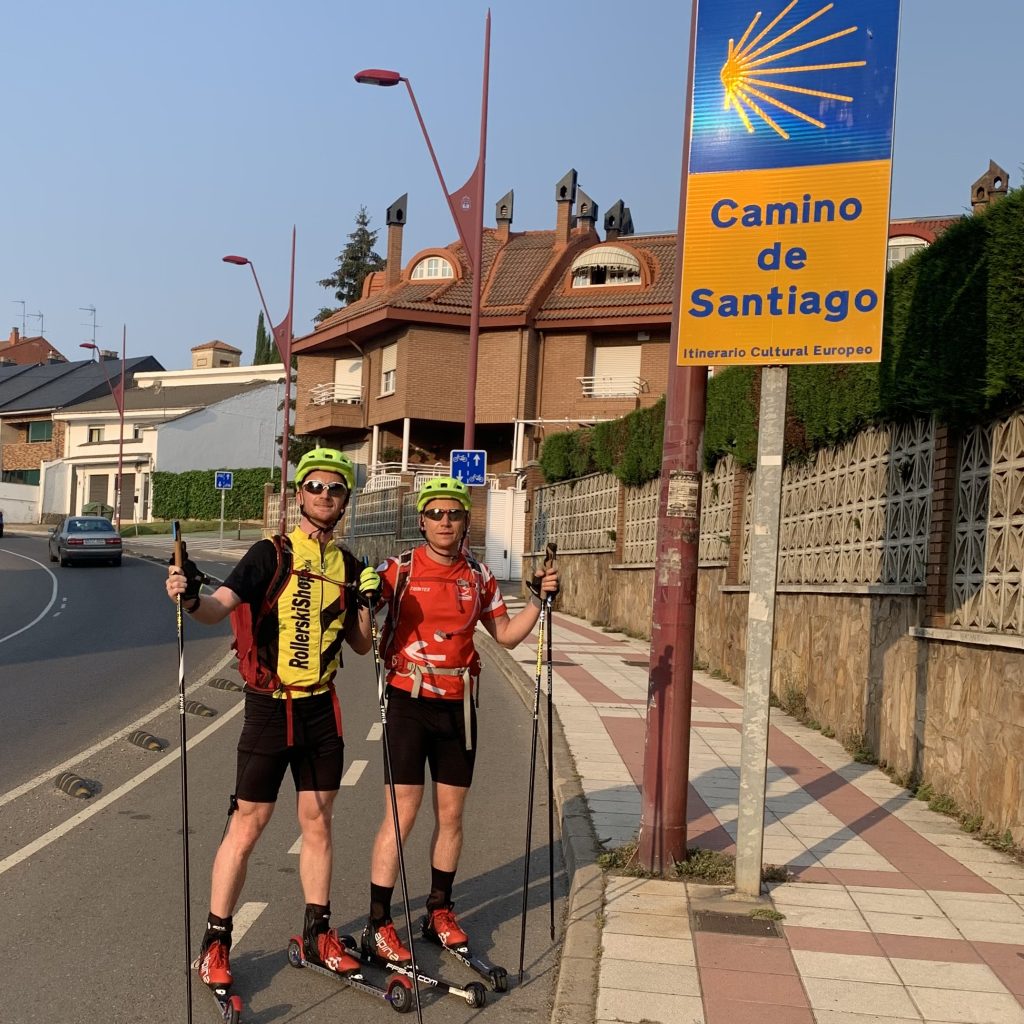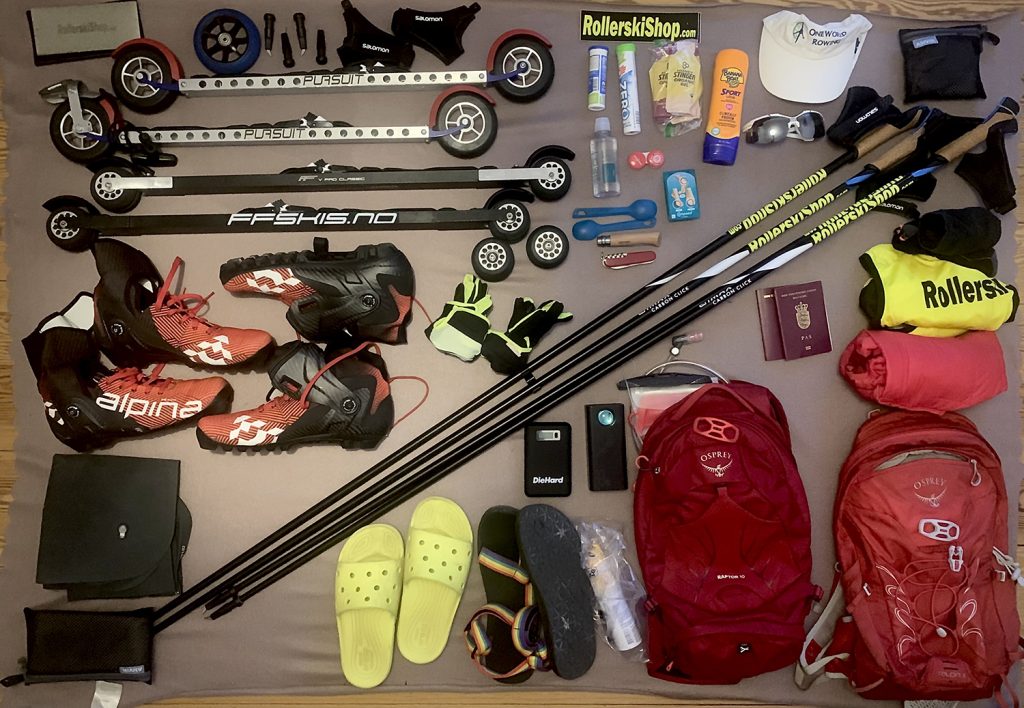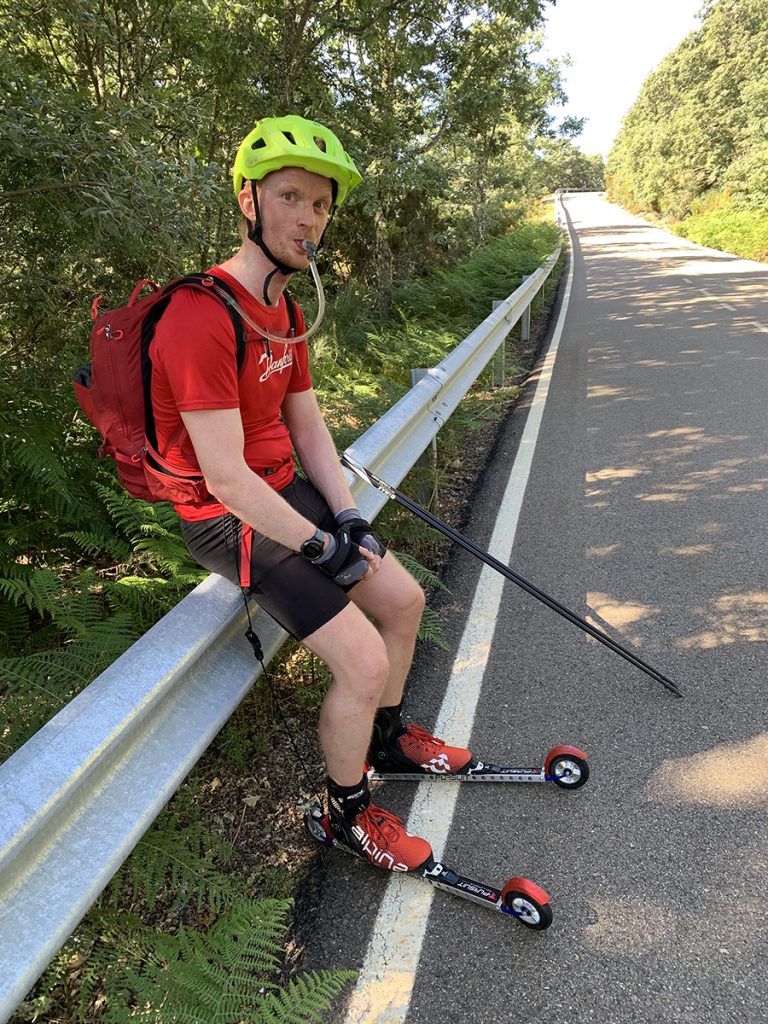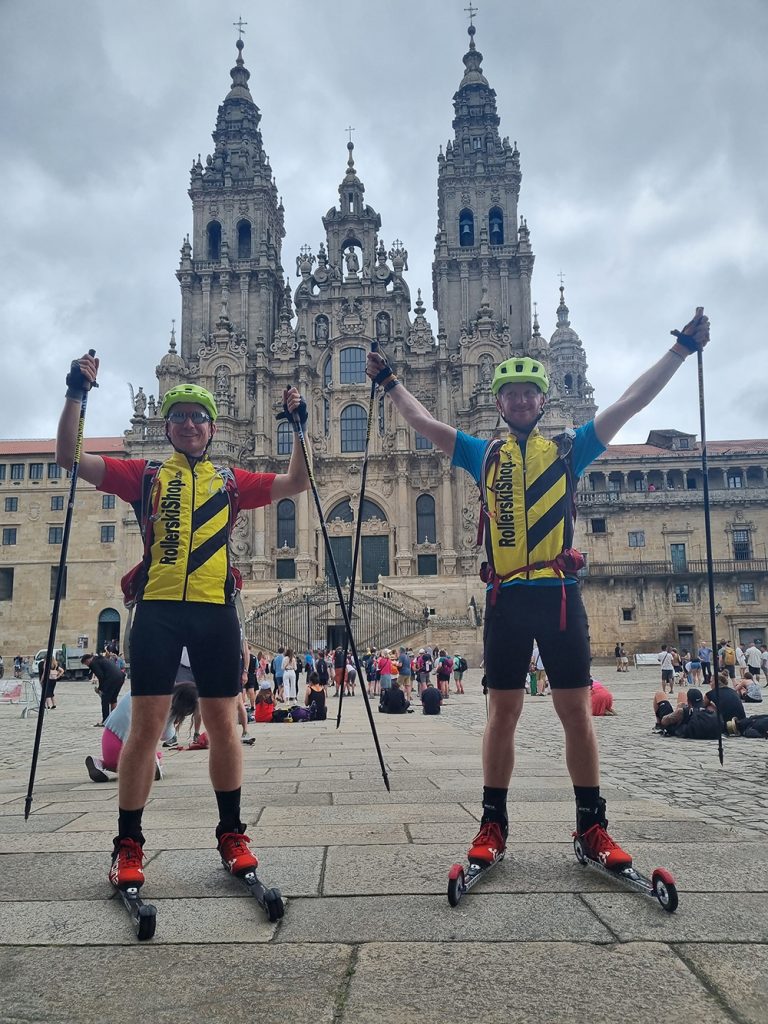For many people, just getting out to rollerski on the local bike path is accomplishment enough. But rollerskiing 360 kilometers over six days along the famed Camino de Santiago in northwestern Spain? Now that’s some feat!
First, some background: Since the ninth century, pilgrims have walked the Camino, which now consists of multiple routes, all joining up and leading to the tomb of St. James at the Cathedral of Santiago de Compostela. Many are on some sort of spiritual quest, while some make the trek for other reasons. Andrej Bendtsen and Hjalte Paaske fall into the latter group; earlier this summer, the two Danes rollerskied part of the Camino Francés (French Way), from León, Spain, to the cathedral.
The hardest part of their journey? Not surprisingly, the downhills.

Courtesy photo
We recently spoke with the two men via Zoom. Bendtsen, 32, is a rower-turned-skier who works for a Danish firm in Minneapolis. Before moving to the U.S., he competed internationally in rowing, earning World Cup and world championship medals, and cross-trained on skis. Paaske, 31, learned to rollerski while living in Norway and now teaches it at the Aarhus Skiklub in Denmark. He’s also a spinning instructor and the project manager of a philanthropic foundation. The two men met years ago, when both worked for an organization that observed elections in Ukraine.
Bendtsen and Paaske hatched the idea for the trip last year. They then found a couple of sponsors: Rollerskishop.com in Minnesota and the District10.dk shop in Copenhagen. And they were off—even rollerskiing to the airport 4 a.m. on June 28 to catch their flight to Santiago de Compostela. From there, they took buses to León to begin their adventure, which they documented on their Instagram account, @caminoonrollerskis.
Here’s our conversation, edited for clarity.
How did you come up with the idea to rollerski the Camino?
Bendtsen: Hjalte is into long-haul bikepacking trips (Iran through the Caucasus, Turkey and the Balkans to Denmark), and he started wondering if it would be possible to do a rollerski trip. For a long time, I’ve considered joining one of his crazy adventures. He started pitching the Camino trip, and I said, yeah, that should be possible. We didn’t find any good reasons to not do it.
Paaske: I had walked a bit of the Camino; it’s very famous in Europe. My idea was that when you travel by rollerskis, you cannot carry a lot of weight. So it’s very important to have easy access to accommodations. The Camino is famous for its many hostels along the way. The idea was that we would not have to carry a lot of weight in our backpacks because we would have access to all of these hostels.

Were you on a pilgrimage?
Paaske: What Andrej and I did was not in the normal spirit of a pilgrimage. It was very physical and, in many ways, a stressful experience. So we probably didn’t really honor the pilgrimage part of it to the greatest extent. But we definitely learned that the people who walk all of the Camino, their achievement is very impressive and significant and in so many ways, way harder than what we did.
The spirit of our trip was to do something that maybe had never been done before. We met a lot of the real pilgrims, and they thought it was really fun to meet people rollerskiing. Everyone was very surprised. We ended up getting a Camino certification even though we had to discuss what we did with the authorities to see if it was certifiable.
What did you carry with you?
Paaske: Lots of water. It was the middle of summer, and temperatures reached the low to mid-30s Celsius (high 80s to low 90s Fahrenheit). We also carried a set of lightweight casual clothes and lightweight beach shoes. Every day when we arrived at a hostel, we went straightaway for the laundry room and washed our rollerskiing clothes. We used good backpacks that fit well, with our gear tied down so it did not inhibit our rollerskiing. And we carried a few spare parts for our rollerskis.
Did you classic or skate ski?
Bendtsen: Part of our project was to represent both techniques, and it was easy to see the pros and cons of each style, depending on the terrain. On the smaller hills, I was able to skate and carry a bit more speed than Hjalte (who was doing classic). But on the longer hills, I sometimes ran out of fuel and started kind of sliding backwards. But I made it to the top!
Paaske: I think classic technique would be easier for most people. You can go slower, especially uphill.
What was your typical day?
Bendtsen: It changed throughout our journey. In the beginning, we started each day around 9 a.m. But by the afternoon, it was super hot and the traffic increased. We had chosen a route with better pavement, which meant bigger roads and faster traffic. So for the second half of the journey, we started rollerskiing at dawn, when it was cooler and there were fewer cars. Around noon, we would take a lunch break and fill up on calories. In the afternoon, as the temperature rose, we went more slowly and stopped more often for water and coffee. We would arrive at the next hostel ideally around 2 p.m. but sometimes 4 p.m. We would shower, do our laundry, then find a supermarket. We would eat the pilgrim dinners at the hostels, but they did not serve until 7 p.m. So we would eat high-calorie foods from the supermarkets to start recovering. Then at 7 p.m., we would eat our second dinner.

finds respite in the shade. Courtesy photo
What was the hardest or most unexpected part of the journey?
Bendtsen: The downhills. At least from my perspective.
Paaske: I agree. When you rollerski in relatively hilly terrain on roads you have never been on before, you don’t know what’s coming at the bottom of the hill. It was very stressful. We were very conservative, and sometimes we had to walk down some of the hills or brake aggressively. When we looked at Google maps, we thought it would be more rollerskiing-friendly terrain. It was more hilly than we expected.
The wear and tear on our rollerskiing wheels happened faster than we thought it would. The pavement was very hot, so the back wheels wore down way faster than we expected. I didn’t really have a back wheel left when we arrived in Santiago. I had only brought one extra rear wheel on the trip.
What do you like about rollerskiing trips versus bikepacking trips?
Paaske: You are forced to be minimalistic with your luggage on rollerskiing trips. The most common mistake people make while bike touring is they bring too much stuff. They end up having way too much weight. It slows down your speed, and it’s basically unnecessary.
Secondly, rollerski mechanics are simpler than a bike. It doesn’t really require technical skills to fix most issues with a rollerski.
And you know, with rollerskiing, it’s fun to stand out. If you tell someone that you have biked from Denmark to Berlin, they won’t be that impressed because so many people have done that. But when you do it on rollerskis, people start to pay attention. So that’s a fun aspect.

If you did the Camino on rollerskis again, what would you do differently?
Paaske: We would focus on the middle part of the Camino Francés because it’s the least hilly. The downside is that you don’t end up concluding the pilgrimage like most people by arriving in front of the cathedral in Santiago de Compostela. But the roads close to Santiago are just too hilly. It doesn’t matter how expensive your rollerskis, it would be too hilly for everyone. You end up walking down the hills, and that’s just not fun.
The second recommendation is to go in May or September, or even October. Avoid the hottest months of the year. Hot pavement really wears down the wheels way faster than we’re used to in Scandinavia.
It’s also important to mitigate the risk of breaking a pole. We really tried to avoid that scenario. Every time we passed over a grill on the road, we shouted “grill!” One mistake, one broken pole would have ended the trip for both of us. The Camino is great for accommodations and food and so forth. But you can’t find a rollerskiing shop along the way.
What’s your next adventure?
Paaske: In September, I will attempt to rollerski from Aarhus, the second biggest city in Denmark, to Berlin. It’s 650 kilometers in seven days. It’s longer than the Camino, but I expect it will be easier because it’s flatter, and I will have access to rollerskiing shops along the way.